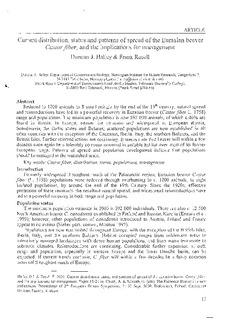| dc.description.abstract | Reduced to 1200 animals in 8 small refugia by the end of the 19th century, natural spread and reintroductions have led to a powerful recovery in Eurasian beaver (Castor fiber L. 1758) range and populations. The minimum population is now 592 000 animals, of which c. 40% are found in Russia. In Europe, beaver are common and widespread in European Russia, Scandinavia, the Baltic states and Belarus; scattered populations are now established in all other countries with the exception of the Caucasus, Iberia, Italia, the southern Balkans, and the British Isles. Further reintroduction are continuing. It seems clear that beaver will within a few decades once again be a tolerably common mammal in suitable habitat over most of its former European range. Patterns of spread and population development indicate that populations should be managed at the watershed scale | |
